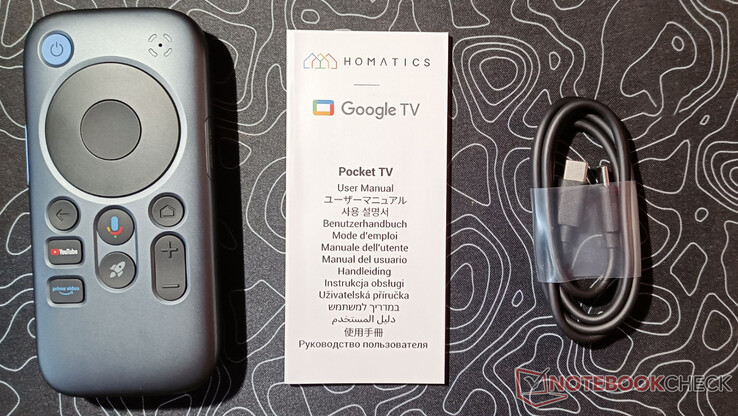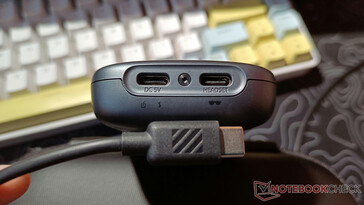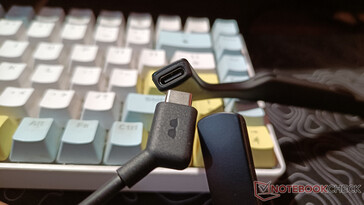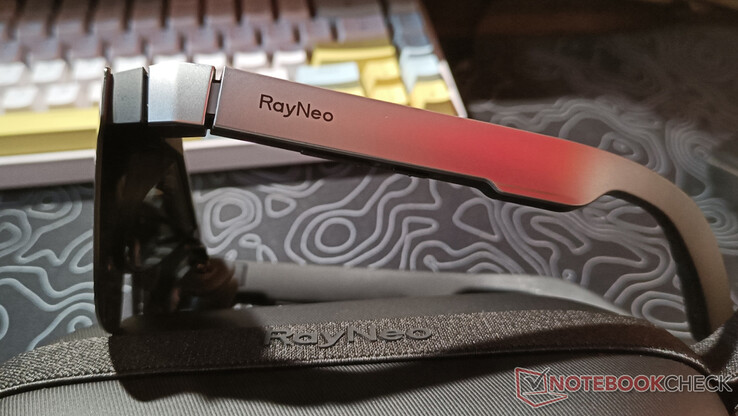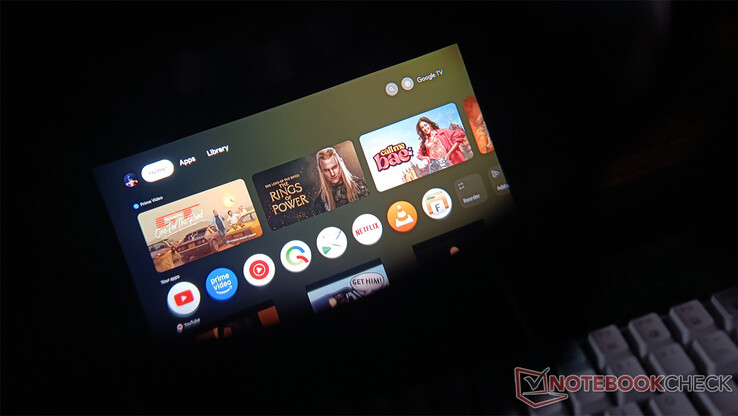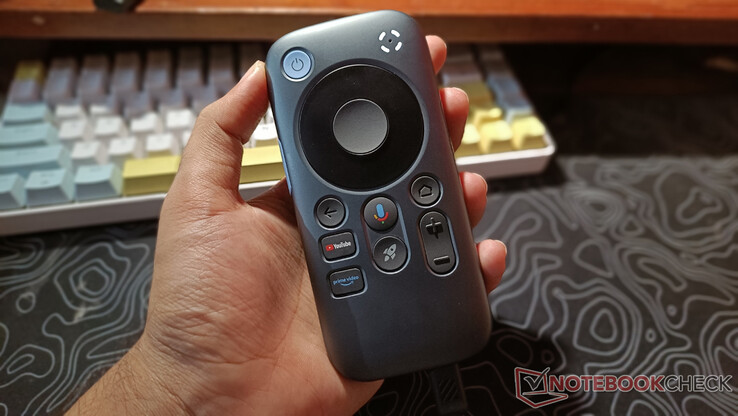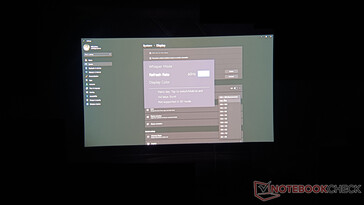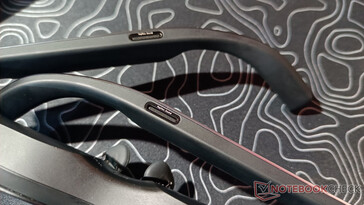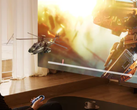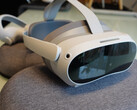RayNeo Air 2s and Pocket TV hands-on review: Portable 201-inch screen entertainment
Rayneo Air 2s launched as better XR glasses than the Air 2. With the same base specs, the new glasses promise the same immersive 201-inch screen experience. However, with tweaks to the Light Engine, they aim for higher clarity and less distorted images.
The company has also teamed up with Homatics to offer Pocket TV as an accessory to the RayNeo Air 2s. Paired with the glasses, you get a Google TV setup that you can enjoy anywhere.
What's In the Box
RayNeo Air 2s package contains the following:
- Air 2s XR glasses
- USB-C cable
- Prescription-lens frame sample
- An extra nose pad
- Cleaning cloth
- User manual
- Carrying case
The Air 2 didn't come with a carrying case, which called for an extra purchase if you wanted to travel with the XR glasses. So, it's good to see RayNeo bundling it with the new Air 2s. As for the Pocket TV, its package includes:
- Pocket TV
- USB-C cable
- User manual
Setting Up the RayNeo Air 2s XR Glasses
Getting the Air 2s to start displaying images is straightforward. It's basically like setting up an external monitor; you just need to connect them to a compatible device. Speaking of which, these XR glasses have universal compatibility, and they will work with any device with a USB-C port that has DisplayPort Alt mode. That includes smartphones, gaming handhelds, tablets, laptops, and, of course, the Pocket TV.
As I got the Pocket TV with the kit, I will mainly talk about the experience when the glasses are paired with it. This portable Google TV device features two USB-C ports. One of them is for charging, and the other is for display output. The angled USB plug of the cable that the Air 2s comes with goes into the port of the XR glasses, and the straight plug into the display output port of the Pocket TV.
Making Adjustments to Get a Better Fit
After putting the headset on, you need to go through the setup process of Pocket TV. It's the same as setting up any other Google TV device. During this process, you may also find that the screens of the XR glasses are feeling a little off. For example, I found certain parts of the displays out of focus from my vision. That's basically when you need to make some adjustments to get a better fit.
The glasses offer three levels of adjustment. First is the nose pad, which you can swap out with a "Large" one that comes in the box. The "Medium" worked for me, but RayNeo should've also added a "Small" option. This nose pad can also be pulled out or pushed back to get a better fit.
Next, you may need to adjust the arms to get a proper vertical angle on the two screens in the XR glasses. The RayNeo Air 2s arm can be set in three positions. You will need to experiment with each of them and see if you can view the full images on the screens. Lastly, the angle of the lenses can be adjusted, which comes in handy to reduce the corner distortions.
The XR Experience With Pocket TV
One of the main highlights of the RayNeo Air 2s is the 201-inch display experience. While such a large display may sound great, I've often adjusted the focal point to get a comfortable viewing experience. There's a nifty feature on Pocket TV that somewhat solved this issue. It can basically reduce the screen size, which makes the corners easy to see and less distorted for me.
Nonetheless, these XR glasses come with two Sony micro-OLED displays with ten levels of brightness control. Given that the Air 2s don't have electrochromic film controls for the opaqueness, it's good to see that the displays can get bright. Speaking of which, as there's no opacity control, you can't tune the tint down to see your surroundings easily. So, these will feel just like a regular pair of sunglasses.
Another notable aspect is the refresh rate. These micro-OLED displays can switch between 120 Hz and 60 Hz refresh rates. The former is more for gaming, and as you can pair the Air 2s XR glasses with a gaming laptop or a handheld, this 120 Hz refresh rate support can lead to an enjoyable on-the-go gaming experience.
As for the Pocket TV, you get a proper Google TV experience. There are more than enough buttons to navigate through the operating system and adjust different parameters, and thanks to the built-in microSD card slot, you can even get local media playback. However, I've noticed that it can get relatively hot over time. To be specific, it got a bit uncomfortable to hold after about an hour of streaming.
Image Quality
The Sony micro-OLED displays on the RayNeo Air 2s can display sharp images. Once you get the XR glasses adjusted and get all areas in focus of your vision, you can get an immersive viewing experience. The color output in the default color setting is vibrant, and the good part is that you can switch the color modes through the on-screen menu. It will pop up once you press the menu button on the left arm.
As mentioned earlier, there are ten levels of brightness control. On the max level, RayNeo says that the micro-OLED displays can peak at 5,000 nits, with "to-eye" brightness rated at up to 600 nits. I've found them to be able to get bright enough for comfortable viewing in a well-lit room. They can also get dim enough for a dark environment. Another aspect worth noting is that the OLED panels on the XR glasses have an FHD resolution, which RayNeo doesn't mention on the official website. Given that the panels are so close to your eyes, I've found this resolution to be more than enough to get detailed picture outputs.
Built-in Speakers for Audio
There are four speakers on RayNeo Air 2s. Two of them are upward-facing, and the other two are downward-facing. While the speakers are decent, they aren't good for noisy environments, such as busy outdoor conditions. In my experience, they feel more like open-ear earbuds.
While the speakers can get loud enough for a good listening experience in relatively quiet environments, you may not want to keep them at full volume. The higher volume levels can bother people nearby. For such cases, RayNeo has integrated Whisper Mode 2.0. This mode directs the sound towards your ears. But again, even in this mode, the loudness isn't good enough for noisy environments.
RayNeo Air 2s With Other Devices
As mentioned earlier, the Air 2s XR glasses will work with any device with a USB-C port featuring DisplayPort Alt mode. I don't have a compatible phone, but I did try it out with my laptop. The experience is the same as you get with Pocket TV, but with such a setup, you get more screen real estate to get things done.
Another thing worth mentioning is that the RayNeo Air 2s can show 3D content. However, the source needs to be 3D as well.
Pros
+ Immersive 201-inch screen experience
+ Detailed images with vibrant colors in the default mode
+ 120 Hz refresh rate support for smooth gaming
+ Multiple adjustment points on the XR glasses for a comfortable fit
+ Whisper Mode 2.0 allows private listening
+ Pocket TV has WiFi 6 and can provide a good portable Google TV experience
Cons
– The Pocket TV can get quite warm after an hour of use
– Glasses ship with only two nose pads
– The large nature of the micro-OLED displays can lead to distorted corners for some
– Speakers can't get loud enough for enjoyable listening in noisy environments
Conclusion
The RayNeo Air 2s stand as a slightly more affordable option than the Xreal Air 2 Pro. However, the latter XR Glasses, with a regular price tag of just $50 more, have electrochromic dimming. That allows you to adjust the opacity and lower it when needed to see your surroundings. But even without it, for the price, the Air 2s are solid XR glasses if you want to enjoy immersive content without getting large-sized external displays.
These glasses are comfortable to wear, and the adjustment options make it easier to get a good fit. However, the 201-inch experience that they aim to offer can be a problem for some. As I've experienced, the large nature of the screen can lead to distortions in the corners. But the good part is that the Pocket TV has a display scaling feature that lets you get the screen size smaller
Speaking of the Pocket TV, it pairs well with the Air 2s, and this combination can be a good on-the-go entertainment solution for those who travel a lot. The Pocket TV can also act like a power bank, a feature that can come in handy in some instances. However, it does tend to get hot, even when you're using it with the XR glasses. The good part is that you don't really need to keep on holding it while using it. So, the overheating issue isn't a dealbreaker for the combo.
Pricing and Availability
You can purchase the RayNeo 2s from the official website or from Amazon. These XR glasses generally go for $399.99. As for the Pocket TV, it is also available on both the official website and Amazon. It typically costs $179.99. If you want to purchase both at the same time, RayNeo has a combo package that costs $539.99, which is $40 less from the total.
Transparency
The selection of devices to be reviewed is made by our editorial team. The test sample was given to the author by the manufacturer free of charge for the purposes of review. There was no third-party influence on this review, nor did the manufacturer receive a copy of this review before publication. There was no obligation to publish this review. We never accept compensation or payment in return for our reviews. As an independent media company, Notebookcheck is not subjected to the authority of manufacturers, retailers or publishers.
This is how Notebookcheck is testing
Every year, Notebookcheck independently reviews hundreds of laptops and smartphones using standardized procedures to ensure that all results are comparable. We have continuously developed our test methods for around 20 years and set industry standards in the process. In our test labs, high-quality measuring equipment is utilized by experienced technicians and editors. These tests involve a multi-stage validation process. Our complex rating system is based on hundreds of well-founded measurements and benchmarks, which maintains objectivity. Further information on our test methods can be found here.






